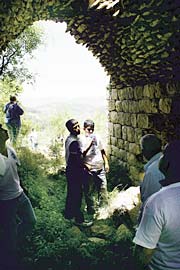Neta Rotem, a 23-year-old college student, stood last week at the entry to the Jerusalem theater. Across the theater grounds hurried attendants to the "Amichai Prize" award ceremony for lifetime achievement for the poet and author Nurit Zarchi. Rotem handed them fliers, which on one side read, "Remember the cactuses you saw on field trips? They were the fences around Palestinian villages," and on the other side a summary of the Arab history of the Talbieh neighborhood where the theater resides.
"We use fliers, films, photographs and testimonies of refugees to bring the Arab history of the neighborhood 'to life,'" explains Rotem. "Today Talbieh is one of the wealthiest neighborhoods in the city. Five minutes from here is the residence of the prime minister, the Belgian consul, and the Goethe Institute. But the neighborhood has a history. In the middle of February 1948 Haganah forces passed through here and called on the residents, most of the Palestinians, to leave. Some fled to East Jerusalem, Lebanon or Egypt and their homes were handed over to Jews. To my regret, most Israelis are not willing to acknowledge the simple facts, and some of them are not aware that whole villages were destroyed."
Rotem's actions are part of the "Nakba 60" project, a coalition of five Jewish and Palestinian organizations that was founded about half a year ago. "The purpose is to raise awareness of the 'Nakba' (the day of the tragedy) coming up to the sixtieth anniversary events in May 2008," explains Lotan Raz, an activist in the coalition. "One of the initiatives was to hold four evenings in Jerusalem in places where there were abandoned villages: The new central station (next to Lifta), Emeq Refa'im (Baq'a), Ayn Karem and the theater. The events will take place in the week between Israeli Independence Day and Nakba Day, which is today. Two days ago a tour was held with Palestinian refugees to the abandoned homes of Lifta." The coalition is funded by the Swiss organization EPER, which promotes co-existence in 45 countries, including Sudan and Sri Lanka.
At the entry to the theater activists gathered around a projector that screened photographs of the Arab houses of Talbieh and of the remains of Lifta and Deir Yassin (Givat Shaul). Against the background of the photographs were testimonies of Palestinian refugees.
Responses among passersby at the theater ranged from angry to indifferent. "Leave the country if you don't like it," a woman shouts. Others take fliers. "Changing consciousness takes a long time," says coalition activist Tamar Avraham. "We go against a narrative that is very strong, that presents Independence Day with only its positive side. I deal with Jewish memory in my work at Yad Vashem, and therefore it was natural for me. Some of the people that I spoke to hurried to say 'the Nakba and the Holocaust are not the same thing,' even though we never stated that the events were similar. There is Israeli fear that dealing with the Nakba will erase the memory of the Holocaust, and this fear is something we are trying to change."
After an hour police officers neared the theater. Raz hurried to shut off the microphone and the projector. The police asked "the crowd to disperse." Attempts to explain that this was a "social event" failed. "Events to commemorate the Nakba are identified also with opposition to the establishment, and in the past demonstrations ended in violent clashes with police. Ironically, in these of all events there is no difference between Israelis and Palestinians," says Raz.



